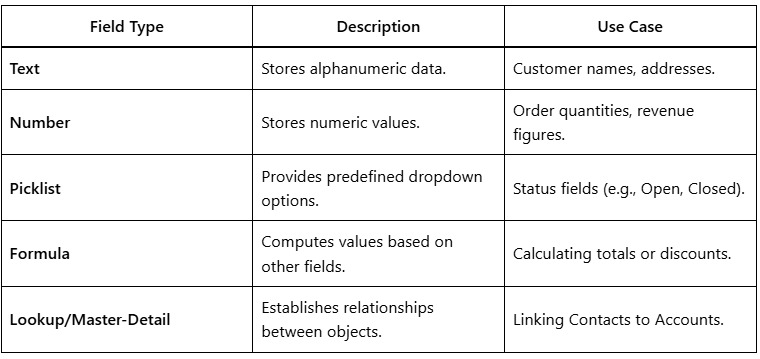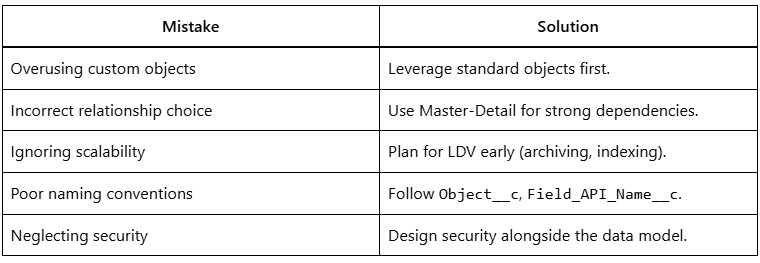Salesforce Data Modeling: An Architect’s Decision Guide

Introduction: Salesforce Data Modeling
Salesforce is a leading Customer Relationship Management (CRM) platform that enables organizations to manage customer interactions, automate business processes, and derive actionable insights from data. However, the effectiveness of Salesforce heavily depends on how well the underlying data is structured. Poor data modeling can lead to performance bottlenecks, data redundancy, security vulnerabilities, and scalability challenges.
This guide provides an in-depth exploration of Salesforce data modeling, covering fundamental concepts, architectural considerations, best practices, and advanced techniques. Whether you are a Salesforce architect, developer, or administrator, this guide will help you design a robust, scalable, and efficient data model tailored to your business needs.
Table of Contents
1. Understanding Salesforce Data Modeling
1.1 What is Data Modeling?
Data modeling in Salesforce refers to the process of defining how data is stored, organized, and interconnected within the platform. It involves:
- Objects (Entities): Tables that store data (e.g., Account, Contact, Opportunity).
- Fields (Attributes): Columns within objects (e.g., Name, Email, Amount).
- Relationships: Logical connections between objects (e.g., lookup, master-detail).
1.2 Importance of Data Modeling in Salesforce
A well-designed data model ensures:
- Data Integrity: Prevents duplicate or inconsistent data.
- Performance Optimization: Reduces query execution time and improves report generation.
- Scalability: Accommodates business growth without requiring major redesigns.
- Security Compliance: Ensures proper data access controls are in place.
2. Core Components of Salesforce Data Modeling
2.1 Standard vs. Custom Objects
Salesforce provides standard objects (e.g., Account, Contact, Lead) that come pre-built with the platform. Custom objects are user-defined and cater to unique business requirements.
Decision Criteria:
1. Use Standard Objects When:
- The built-in functionality meets business needs.
- Integration with other Salesforce features (e.g., Reports, Dashboards) is required.
2. Use Custom Objects When:
- Business processes require unique data structures.
- Standard objects lack necessary fields or relationships.
2.2 Field Types and Their Applications
Salesforce supports various field types, each serving a specific purpose:

Best Practices for Field Design:
- Use picklists instead of free-text fields to enforce data consistency.
- Limit the number of long text areas to avoid performance issues.
- Use formula fields for calculations rather than storing redundant data.
2.3 Relationship Types in Salesforce
Salesforce supports several relationship types, each serving different use cases:
A. Lookup Relationship
- Definition: A non-hierarchical link between two objects.
- Behavior: Deleting the parent record does not delete the child record.
- Example: A “Project” custom object linked to an Account.
B. Master-Detail Relationship
- Definition: A tightly coupled relationship where the child record cannot exist without the parent.
- Behavior: Deleting the parent record automatically deletes all child records.
- Example: Opportunity Line Items related to an Opportunity.
C. Many-to-Many Relationships (Junction Objects)
- Definition: Used when multiple records from one object relate to multiple records in another.
- Implementation: Requires an intermediate junction object.
- Example: A “Course Enrollment” object linking students to courses.
D. Hierarchical Relationship
- Definition: Exclusive to the User object, used for organizational hierarchies.
- Example: Defining manager-subordinate relationships.
Choosing the Right Relationship:

2.4 Schema Builder: Visual Data Modeling Tool
Salesforce’s Schema Builder provides a drag-and-drop interface for designing and modifying data models.
Key Features:
- Visual representation of objects and relationships.
- Ability to create and modify fields directly.
- Supports both standard and custom objects.
Best Practices:
- Use Schema Builder to validate relationships before implementation.
- Avoid creating overly complex models that hinder usability.
3. Data Model Design Strategies
3.1 Normalization vs. Denormalization
1. Normalization: Splits data into multiple related tables to reduce redundancy.
- Pros: Better data integrity, efficient storage.
- Cons: Complex queries with multiple joins.
2. Denormalization: Combines data into fewer tables for faster queries.
- Pros: Improved reporting performance.
- Cons: Increased storage usage, potential data duplication.
When to Normalize?
- When data accuracy is critical (e.g., financial systems).
- When storage optimization is a priority.
When to Denormalize?
- For reporting and analytics performance.
- When complex joins degrade system performance.
3.2 Indexing for Performance Optimization
- Standard Indexes: Automatically created on primary keys (e.g., Id).
- Custom Indexes: Can be added to frequently filtered fields.
Best Practices for Indexing:
- Index fields used in WHERE clauses, JOIN conditions, or ORDER BY statements.
- Avoid over-indexing, as it increases storage overhead.
3.3 Handling Large Data Volumes (LDV)
Salesforce defines Large Data Volumes (LDV) as organizations with millions of records.
Strategies for LDV:
1. Data Archiving:
- Move historical data to Big Objects or external systems.
2. Selective Querying:
- Use selective filters (indexed fields) to avoid full table scans.
3. Asynchronous Processing:
- Use Batch Apex for large data operations.
3.4 Security and Sharing Model Considerations
1. Salesforce’s security model includes:
- Org-Wide Defaults (OWD): Baseline access settings (Private, Public Read/Write).
- Profiles & Permission Sets: Control object and field-level access.
- Sharing Rules: Extend access beyond OWD settings.
2. Security Best Practices:
- Start with restrictive OWD (e.g., Private) and open access as needed.
- Use role hierarchies to mirror organizational structures.
4. Advanced Data Modeling Techniques
4.1 Big Objects
- Designed for massive, rarely changing datasets (e.g., audit logs).
- Supports billions of records but has limited query flexibility.
4.2 External Objects (Salesforce Connect)
- Allows integration with external databases (e.g., SQL, ERP systems).
- Uses OData or external data sources for real-time access.
4.3 Polymorphic Relationships
- A field that can reference multiple object types (e.g., Task’s “Related To” field).
- Useful for flexible associations but complicates reporting.
4.4 Optimizing for Reporting & Analytics
- Use roll-up summary fields for aggregations.
- Avoid polymorphic fields in reports.
- Consider denormalization for complex reporting needs.
5. Common Data Modeling Mistakes & Solutions

6. Tools for Salesforce Data Modeling
- Schema Builder – Visual data model designer.
- Salesforce Inspector – Browser extension for metadata analysis.
- ERD Tools (Lucidchart, Draw.io) – For external documentation.
- Force.com IDE – For advanced metadata management.
7. Key Takeaways
Salesforce data modeling is a critical architectural discipline that impacts performance, scalability, and usability. By following best practices such as choosing the right relationships, optimizing for large data volumes, and integrating security early. You can build a future-proof data model that aligns with business needs.

